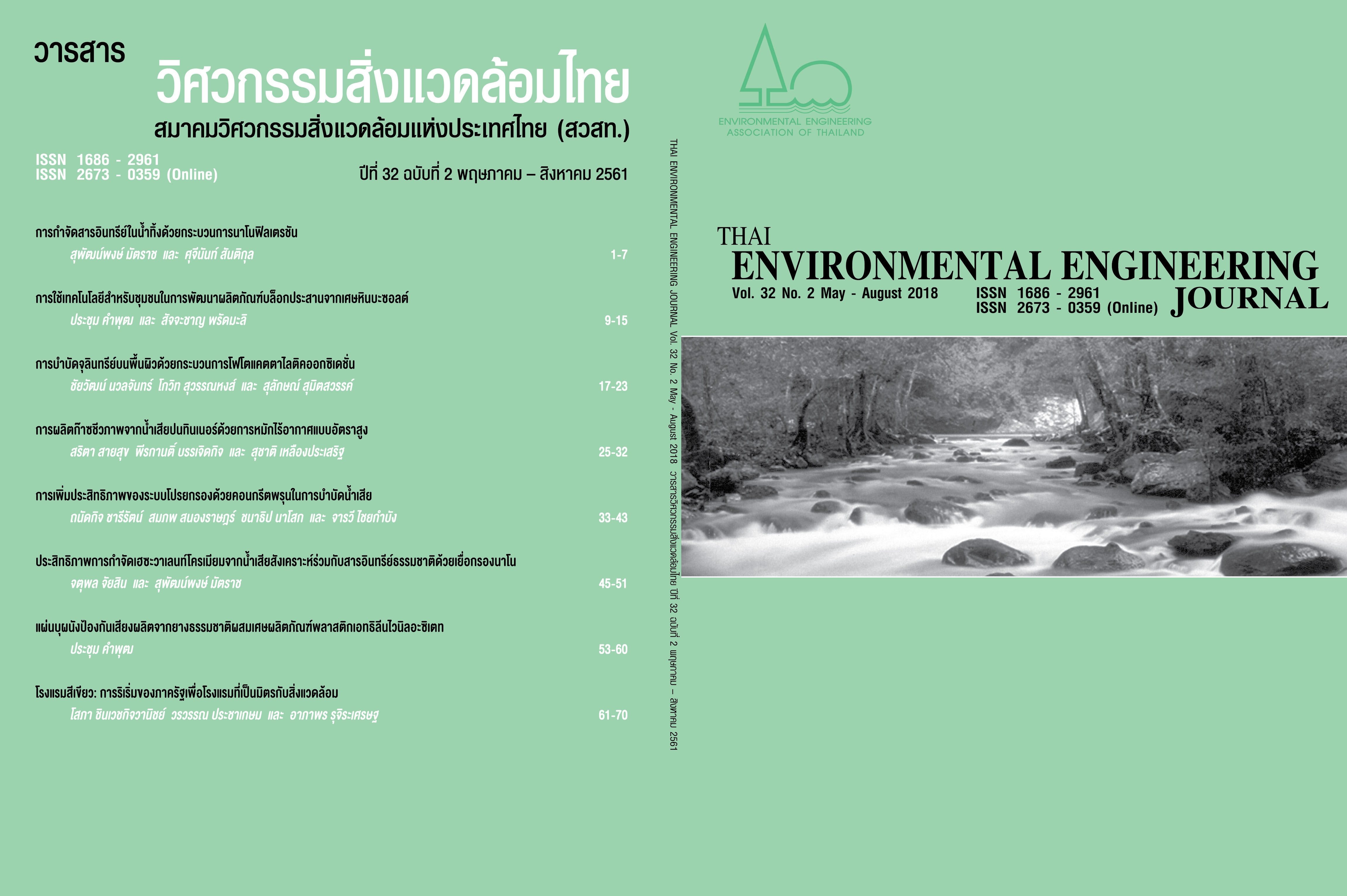Performance of Nanofiltration Membrane on Removal of Hexavalent Chromium from Synthetic Wastewater and Natural Organic Matter
Main Article Content
Abstract
This objective of this research was to study the removal performance of hexavalent chromium from synthetic wastewater and natural organic matter (NOM) using dead-end nanofiltration (HL4040FN, GE water and process technology). Solution conditions were controlled with ionic strength of 0.01 M and 10 mg/L NOM, and solution pH of 7. The concentrations of hexavalent chromium were adjusted about 10, 20 and 30 mg/L with constant operating pressure of 30 psi. Experimental results found that increased concentrations of hexavalent chromium decreased solution flux during filtration and slightly increased chromium rejection. The removal efficiency of NOM was relatively high, while solutions having hexavalent chromium from synthetic wastewater and NOM inhibited greater flux decline and removal efficiency of hexavalent chromium than those having only hexavalent chromium from synthetic wastewater.
Article Details
References
[2] Jaiyong, S., Ajsakorn, O. and Rimwatthana, A. 2540. Absorption of Hexavalent Chromium by Chlorella sp. Bachelor Thesis of Science. Faculty of Industrial Education King Mongkut's Institute of Technology Ladkrabang.
[3] Kilduff, J.E., Mattaraj, S. and Belfort, G. Flux decline during nanofiltration of naturally occurring dissolved organic matter: effect of osmotic pressure, membrane permeability, and cake formation. J. Membrane Sci. 239(1): 39-53.
[4] Conlon, W., and McClellan, S., 1989. Membrane Softening: A Treatment Process Comes of Age. Journal AWWA. 81(11): 47-51.
[5] Yildiz, E. Nuhoglu, A. Keskinler, B. Akay, G. and Farizoglu, B. 2003. Water softening in a crossflow membrane reactor. Desalination. 159(2): 139-152.
[6] Bruggen, Bart Van der and Carlo Vandecasteele. 2003. Removal of pollutants from surface water and groundwater by nanofiltration: overview of possible applications in the drinking water industry. Environ. Pollut. 122: 435-44.
[7] Conteras, A.E., Albert Kimb and Qilin lia. 2009. Combined fouling of nanofiltration membranes: Mechanisms and effect of organic matter. J. Membrane Sci. 327:
87-95.
[8] Tu, S., Varadarajan, R. and Massoud, P. 2005. A pore diffusion transport model for forecasting the performance of membrane processes. J. Membrane Sci. 265: 29-50.
[9] Vrouwenvelder, J.S., Kappelhof, J.W.N.M., Heijrnan, S.G.J., Schippers, J.C., van der Kooija D. 2003. Tools for fouling diagnosis of NF and RO membranes and assessment of the fouling potential of feed water. Desalination. 157: 361-365.
[10] Kilduff, J. E., Mattaraj, S., Pieracci, J. P. and Belfort, G. 2000. Photochemical modification of polyether sulfone and sulfonated polysulfone nanofiltration membranes for control of fouling by natural organic matter. Desalination. 132: 133-142.
[11] Cho, J., Amy, G. and Pellegrino, J. 2000. Membrane Filtration of Natural Organic Matter: Comparison of flux decline, NOM rejection, and foulants during filtration with three UF membranes. Desalination. 127: 283-298.


